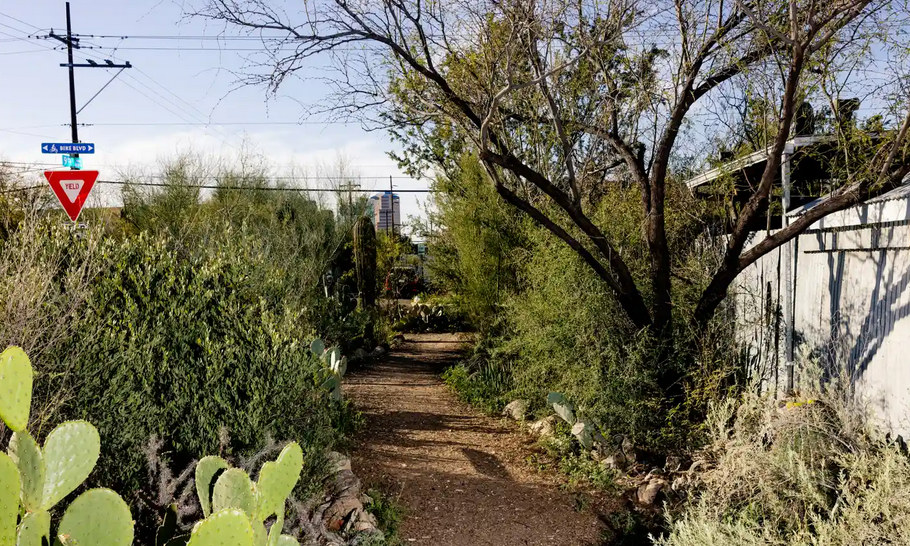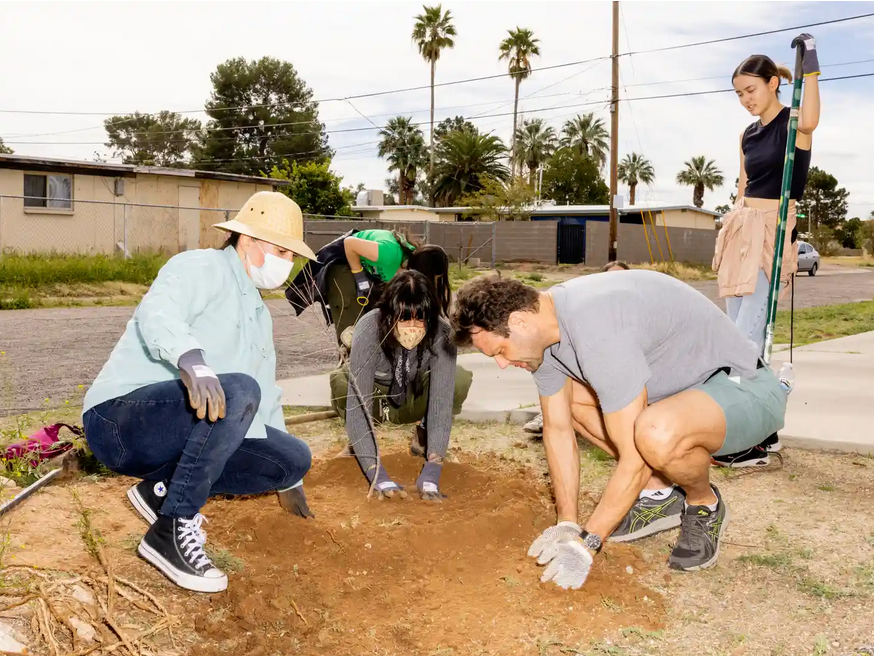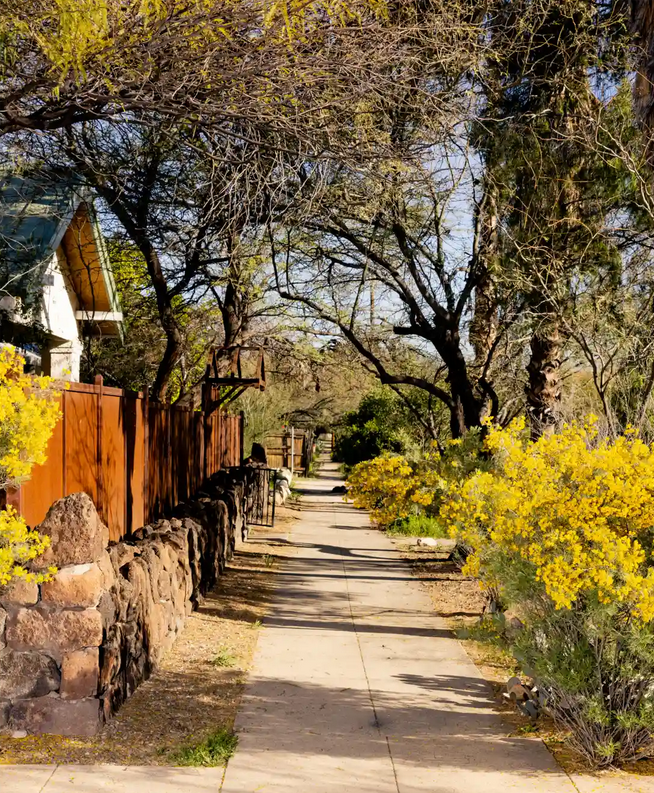Dunbar Spring near downtown Tucson, Arizona is a neighborhood with unpaved sidewalks lined with native, food-bearing trees and shrubs fed by rainwater diverted from city streets. One single block has over 100 plant species. This urban food forest was planted almost 30 years ago and provides food for residents and roughage for livestock. The tree canopy also provides relief to residents in one of the hottest cities in the nation. Dunbar Spring is a model for other areas grappling with increased heat, drought and food insecurity.
 “We’re creating a living pantry,” said Brad Lancaster, a resident and co-founder of the Dunbar/Spring Neighborhood Foresters organization, which planted the urban food forest. The plan, headed up by Lancaster, was to plant multi-use drought-tolerant shade trees in streetside basins that could capture rainwater and create “a more livable community”, he said.
“We’re creating a living pantry,” said Brad Lancaster, a resident and co-founder of the Dunbar/Spring Neighborhood Foresters organization, which planted the urban food forest. The plan, headed up by Lancaster, was to plant multi-use drought-tolerant shade trees in streetside basins that could capture rainwater and create “a more livable community”, he said.
 Neighborhood foresters have planted more than 1,700 trees and thousands more understory plants, transforming Dunbar Spring into an urban food forest fed by rainwater. “We can plant resilient native trees that are not dependent on imported water for irrigation,” said Lancaster, standing near a series of curb cuts that pull storm water off the street into sidewalk plantings. “Trees shade the street, reduce heat stress and provide food for our neighborhood.”
Neighborhood foresters have planted more than 1,700 trees and thousands more understory plants, transforming Dunbar Spring into an urban food forest fed by rainwater. “We can plant resilient native trees that are not dependent on imported water for irrigation,” said Lancaster, standing near a series of curb cuts that pull storm water off the street into sidewalk plantings. “Trees shade the street, reduce heat stress and provide food for our neighborhood.”
The work in Dunbar Spring, along with Lancaster’s books and website, have inspired people worldwide to take up water harvesting to irrigate native food-bearing street trees. “In almost every neighborhood in Tucson, you can now find at least one property doing this,” he said.
 The work of Dunbar Spring neighborhood foresters has also informed Tucson’s climate action plan, including legalizing citywide rainwater harvesting and planting arid-adapted trees. Fatima Luna, the city of Tucson’s climate and sustainability adviser, said Dunbar Spring demonstrates how storm water harvesting can be implemented at the neighborhood scale “using low-tech, low-cost technologies that direct runoff into vegetated basins where it infiltrates the soil and supports native vegetation”.
The work of Dunbar Spring neighborhood foresters has also informed Tucson’s climate action plan, including legalizing citywide rainwater harvesting and planting arid-adapted trees. Fatima Luna, the city of Tucson’s climate and sustainability adviser, said Dunbar Spring demonstrates how storm water harvesting can be implemented at the neighborhood scale “using low-tech, low-cost technologies that direct runoff into vegetated basins where it infiltrates the soil and supports native vegetation”.
And Tucson’s mayor, Regina Romero, launched Tucson Million Trees in 2020, an initiative to plant 1m drought-tolerant shade trees to help mitigate the impact of climate change. “If climate change continues at its current pace, cities in the south-west such as Tucson could experience as much as 45 days more per year with temperatures above 90F [32C] by 2100,” said Ladd Keith, an assistant professor at the University of Arizona working at the intersection of urban planning and climate change.
 Shade can have a profound effect on urban neighborhoods. One day in September, the temperature on an exposed street in Dunbar Spring was 123F (50C), while a shaded street was just 85F (30C) – a 38F (20C) difference.
Shade can have a profound effect on urban neighborhoods. One day in September, the temperature on an exposed street in Dunbar Spring was 123F (50C), while a shaded street was just 85F (30C) – a 38F (20C) difference.
On rainy days, Dunbar Spring looks completely different. First Avenue, which runs through the entire neighborhood, transforms into a rushing stream, filling streetside basins, planted roundabouts and other earthworks with water. These water management practices, Lancaster said, are rooted in Indigenous rainwater harvesting techniques, in particular Ak-Chin runoff farming, practiced in the Sonoran desert for millennia. These time-tested water harvesting techniques, coupled with climate-smart desert food production, will be crucial in building food security in the warming south-west, especially as agriculture consumes 74% of Arizona’s fresh water.
 For Lancaster, surviving and thriving in an increasingly hot and dry world will require dramatic and necessary changes to how we live. “We need to adapt ourselves and our practices in a way that doesn’t just serve us but the living systems that allow us to be here,” he said.
For Lancaster, surviving and thriving in an increasingly hot and dry world will require dramatic and necessary changes to how we live. “We need to adapt ourselves and our practices in a way that doesn’t just serve us but the living systems that allow us to be here,” he said.
You can read the original article at www.theguardian.com

